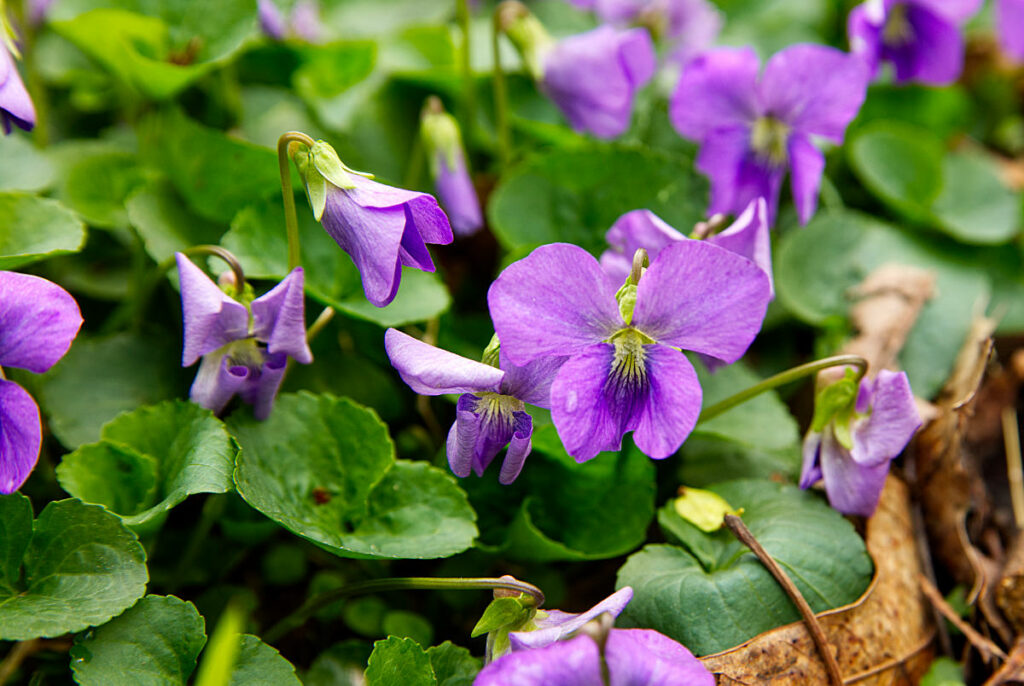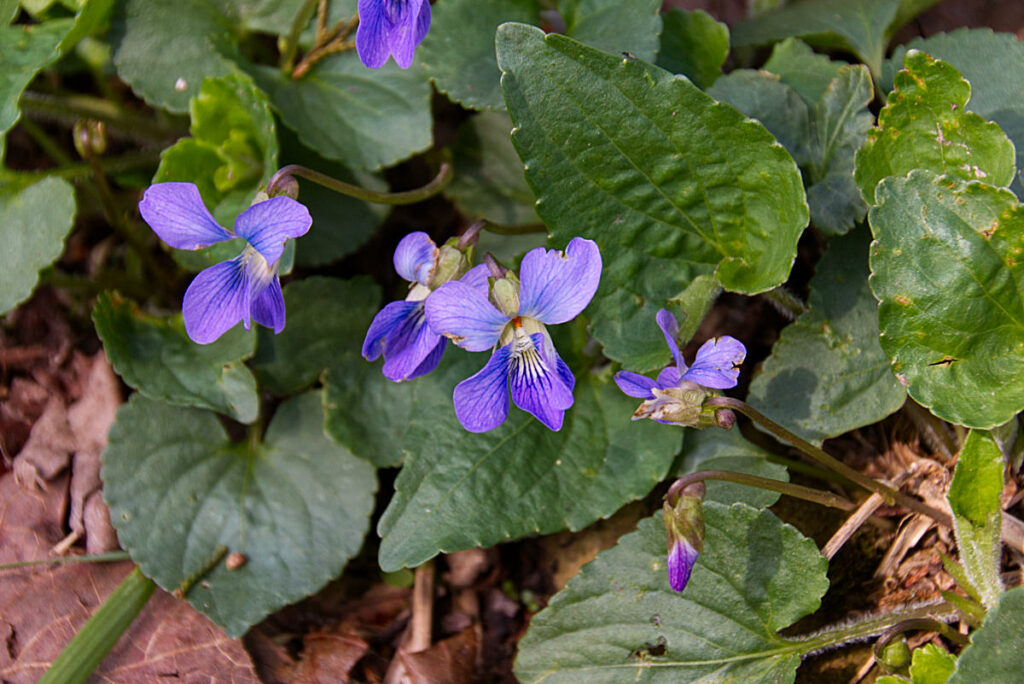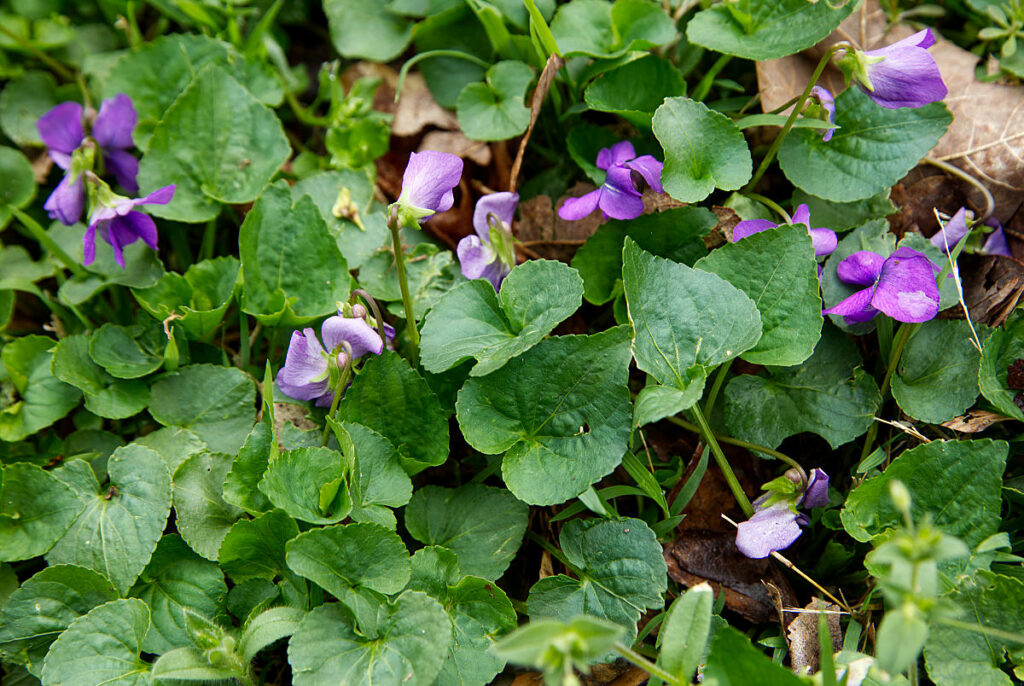
Are you ready to explore the enchanting world of wildflowers? Look no further than the common blue violet! This charming little plant has been capturing hearts for centuries, from Shakespeare’s plays to modern-day gardens. But there’s more to this delicate beauty than meets the eye. In this article, we’ll dive into the fascinating world of the common blue violet and uncover the secrets of its natural and cultural history. Short answer: The article is about the common blue violet, a beloved wildflower with a rich history and many surprising properties.
Many consider the common blue violet to be a weed. Nothing could be further from the truth. In fact, you may first notice these hardy little plants when spring arrives. They bloom in early spring with a spray of small blue to purple flowers. Read on to find out about the edible and medicinal uses of wild common blue violet.
*Disclaimer- The information presented in this article is for educational purposes. Wild edible plants may have look-alikes that are not edible and can even be toxic. Make sure you are 100% certain when identifying wild plants for consumption. Seek expert advice prior to foraging for wild edibles if you are unsure about identification.
The Common Blue Violet
Violets are a perennial plant that blooms from early spring through summer. They die back in the winter and reemerge when spring arrives.
There are hundreds of types of violets, so giving identifying characteristics for all of them would not be possible in an article such as this. But the common blue violet is easier to identify when flowering. The plants consist of a rosette of heart-shaped leaves which grow low to the ground. The color of the flowers can be blue to purple. They resemble miniature orchids. They have five petals and are white in the center.
These plants are spread by underground runners, and the flowers do not actually produce seeds. Instead, seeds are produced by small green flowers which arise in autumn and are hidden among the leaves. The seeds are mechanically ejected by the seed pods to spread the seeds when they ripen.
Edible Uses of Common Blue Violet
The leaves and the flowers are edible and safe to consume in even large quantities. The roots should be avoided because they can cause nausea and vomiting so they should not be eaten.
The flowers can be used as a garnish or to add a splash of color to salads and other dishes. They can be used to make jelly, they can be candied, or can be frozen in ice cubes to dress up cold drinks for summer fun.
Recipes
Violet and Wild Onion Frittata
Ingredients:
- 6 eggs
- 2 tablespoons of olive oil
- ½ cup of chopped wild onions
- ½ cup of chopped fresh violets
- ½ teaspoon of salt
- ¼ teaspoon of black pepper
- ¼ cup of grated Parmesan cheese
Instructions:
- Preheat oven to 350 degrees F.
- In a large bowl, whisk together eggs, olive oil, wild onions, violets, salt, and pepper until combined.
- Heat a 10-inch oven-safe skillet over medium heat. Add the egg mixture and cook, stirring occasionally, until the eggs are just set, about 8 minutes.
- Sprinkle Parmesan cheese on top of the frittata and transfer the skillet to the preheated oven.
- Bake until the eggs are set and the cheese is golden; about 10 minutes.
- Slice and serve warm.
Violet Pesto
Ingredients:
-1 cup of fresh violet leaves
-1/4 cup of freshly grated hard sheep cheese
-1/4 cup of toasted pine nuts or walnuts
-1 garlic clove, minced
-1/4 teaspoon of salt
-1/4 cup of extra virgin olive oil
-2 tablespoons of freshly squeezed lemon juice
Instructions:
- Rinse the violet leaves and pat them dry with a paper towel.
- In a food processor, pulse the violet leaves until finely chopped.
- Add the cheese, nuts, garlic, and salt to the food processor and pulse until everything is combined.
- Slowly stream in the olive oil while the food processor is running, then add the lemon juice.
- Taste the pesto and adjust the seasoning as desired.
- Store the pesto in the refrigerator for up to 3 days.
Wild Violet Syrup
Ingredients:
- 2 cups of fresh violet flowers
- 2 cups of sugar
- 1 lemon
- 2 cups of water
Instructions:
- Gently rinse the violet flowers with cold water and pat them dry.
- Place the flowers in a medium saucepan and pour 2 cups of water over it.
- Squeeze the juice of 1 lemon into the saucepan.
- Bring the mixture to a boil then reduce heat and simmer for 15 minutes.
- Strain the mixture through a fine mesh sieve and discard the solids.
- Place the liquid back in the saucepan and add 2 cups of sugar.
- Increase the heat to medium-high and bring the mixture to a boil.
- Lower the heat and simmer for 15 minutes or until the syrup has reached the desired consistency.
- Remove from heat and allow the syrup to cool.
- Pour the syrup into a clean glass bottle or jar and store it in the refrigerator.
Violet and Brie Tartlet
Ingredients:
- 2 sheets of pre-made puff pastry
- 1/4 cup of unsalted butter, softened
- 1/4 cup of all-purpose flour
- 2 tablespoons of granulated sugar
- 2 tablespoons of chopped fresh violets
- 4 ounces of brie cheese, diced
- 2 eggs, beaten
Instructions:
- Preheat oven to 375 degrees F.
- Place puff pastry sheets on a lightly floured work surface and cut each into 4 equal-sized squares. Place on a parchment-lined baking sheet and set aside.
- In a medium bowl, combine the butter, flour, and sugar until it forms a thick paste.
- Divide the paste into 8 equal portions, then spread each portion evenly on the puff pastry squares.
- Sprinkle the chopped violets and diced brie cheese on top of each square, then fold the four corners of each square towards the center, pinching them together to form a tartlet.
- Brush the beaten eggs over the top of each tartlet, then bake for 20-25 minutes, or until golden brown.
- Allow tartlets to cool for 10 minutes before serving.
Wild Violet Salad
Ingredients:
- 2 cups of fresh wild violet leaves, washed and dried
- 1/4 teaspoon of lemon zest
- 2 tablespoons of freshly squeezed lemon juice
- 2 tablespoons of extra virgin olive oil
- 1/4 teaspoon of sea salt
- 1/4 teaspoon of freshly ground black pepper
- 2 tablespoons of chopped fresh chives
Instructions:
- In a medium bowl, combine the wild violet leaves, lemon zest, lemon juice, olive oil, salt, and pepper.
- Gently toss the ingredients together until they are evenly combined.
- Top with the chopped fresh chives and serve.
Violet Jelly Recipe
Recipe
8 cups fresh violet blossoms
3 1/2 cups boiling water
4 cups sugar
1/2 cup bottled lemon juice
1 box (1.75 oz) fruit pectin.
- Pour boiling water over violet blossoms. Steep for 2 hours, stirring every 30 min.
- Strain out blossoms, and place the liquid in a non-metallic saucepan.
- Stir in lemon juice, sugar, and fruit pectin.
- Bring mixture to a full boil and boil for 1 minute.
- Remove from heat and allow to cool slightly while continuing to stir.
- Ladle into clean jars. Use water bath canning to make the jelly shelf-stable.
- If not canning, place in the refrigerator and keep refrigerated to prevent spoilage.
You might also like to try these recipes for Dandelion Flower Jelly or Redbud Jelly.
Eat the Leaves
The leaves can be prepared just like any other greens. They can be eaten raw in salads, although they can be rather bland when raw. You can sautee’ them or steam them for a side dish. They can be added to soups or stews as a thickener. I’m sure you can find loads of uses for them.

How to Harvest
The easiest way to harvest the leaves is to use a pair of scissors and trim them from the plant near the base. Harvest in spring, before the leaves become tough and fibrous over the summer. Many times you will see a flush of new leaves in autumn for a second harvest.
To harvest the flowers simply pinch them from the stem just below the flower. Don’t worry about damaging your plants. Since the flowers you can see do not produce the seeds, you can harvest all you want.
Medicinal Uses
Violet leaves contain a large amount of a substance known as mucilage. Mucilage can form a film that protects the tissues from further irritation. This is a soluble fiber found in many plants which can aid digestion and can even be helpful to lower cholesterol. It also means that it can be used to soothe inflammation in the body. It has traditionally been used to soothe sore throats, digestive issues, and a dry cough.
Other plants that contain large amounts of mucilage include Okra, Mallows such as Marshmallow, and Rose of Sharon.

Conclusion
Now you know about this little plant that may be considered a weed but instead is a very lovely and useful little plant. Try looking for some recipes online and you’ll find lots of uses for the violets in your yard.
If you want to read about other useful wild edible and medicinal plants, check out our blog for more great articles.
FAQs:
Q: Is common blue violet a good ground cover?
A: Yes, common blue violet is an excellent ground cover due to its low height and dense growth habit.
Q: Is common blue violet invasive? A: While common blue violet can spread quickly in ideal growing conditions, it is not considered invasive.
Q: Does common blue violet like shade or sun?
A: Common blue violet prefers partial to full shade, but it can also grow in full sun.
Q: Do wild violets choke out other plants?
A: Wild violets have a dense growth habit, which can sometimes choke out other plants. However, they generally coexist well with other groundcovers.
Q: Why is my yard full of wild violets?
A: Wild violets thrive in moist, shady conditions, so if your yard has these conditions, it’s likely that wild violets will grow and spread quickly.
Q: Are violets good for your yard?
A: Yes, wild violets are beneficial for your yard as they help to control erosion, provide nectar for pollinators, and add a pop of color to your landscape.
Q: Should I pull out violets?
A: It depends on your preferences. If you like the look of wild violets, you can leave them. However, if you want a more uniform look to your lawn, you can pull them out.
Q: Is wild violet the same as Creeping Charlie?
A: No, wild violet and Creeping Charlie are two different plants.
Q: Do deer eat wild violets?
A: Yes, deer will eat wild violets if they are available.
Q: Will Clover choke out violets?
A: Clover can compete with wild violets for resources, but it typically won’t choke them out completely.
Q: What is the best way to get rid of violets in a lawn?
A: Hand-pulling or spot-treating with herbicides are effective ways to control wild violets in your lawn.
Q: Are wild violets bad for the lawn?
A: No, wild violets are not inherently bad for your lawn. However, if they are not managed, they can spread quickly and become too dense.